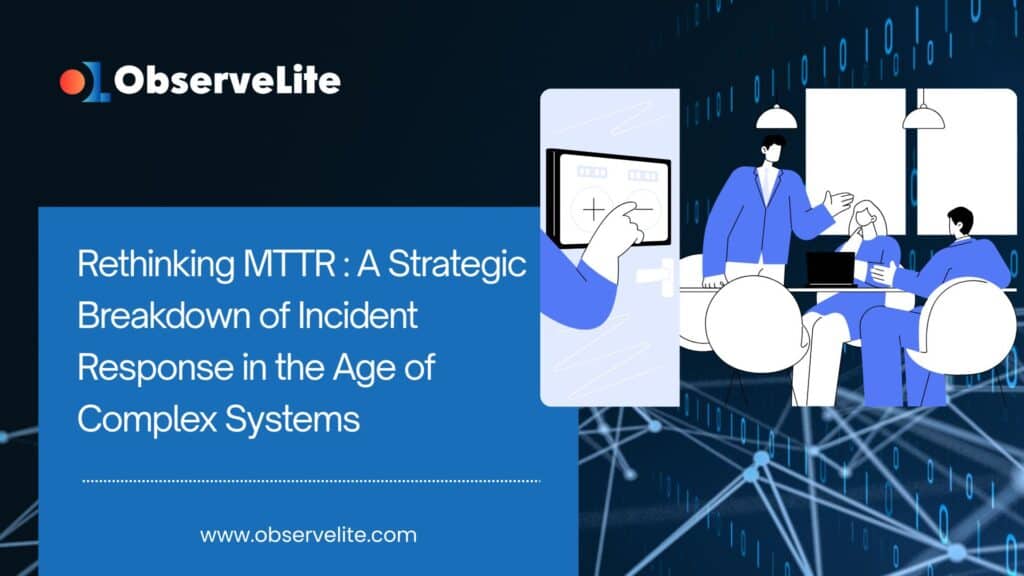Every engineer knows the acronym MTTR—Mean Time to Resolve. But behind that tidy metric is a chaotic ecosystem of missed signals, delayed actions, and blind stabs in the dark. While dashboards glow and alerts fire, the cold reality is this: most organizations aren’t reducing MTTR. They’re simply reacting to it.
To drive real change, we must examine the anatomy of incident response—not through the lens of tools, but through the operational experience of engineers at the frontlines. MTTR is not a singular phase. It’s a chain reaction. Each link—detection, triage, diagnosis, resolution—can either accelerate recovery or drag it into the abyss.
Let’s unpack the lifecycle, phase by phase, and only then explore how emerging intelligence models like generative AI can meaningfully compress time without compromising accuracy.
Detection: When Data Isn’t the Problem, But Meaning Is
In the early moments of a failure, time is already slipping. Not because we can’t detect anomalies—but because our systems can’t discern which anomalies matter.
Traditional monitoring systems were built for static, monolithic environments. They rely on threshold-based alerts, handcrafted rules, or basic pattern-matching. These methods fall short in modern architectures where context defines criticality. A spike in memory usage might be benign at peak hours but catastrophic during off-peak times. Identical metrics, opposite implications.
In microservices ecosystems, telemetry explodes in volume. Logs, metrics, and traces pour in by the second. But what’s missing isn’t data—it’s correlation. Teams are inundated with alerts that lack narrative, forcing engineers to become human interpreters of noise.
The result?
Alert fatigue. Valuable signals buried in seas of irrelevant noise. Detection, as it stands, doesn’t fail from silence. It fails from semantic blindness—the inability to understand why something matters, not just that it occurred.
Triage: The Fog After the Fire
Once an alert is triggered, the clock starts ticking—but resolution doesn’t begin. Instead, teams enter the most uncertain phase: triage.
Here, the task isn’t fixing the issue. It’s answering foundational questions: Is this a real incident? Who owns it? Is it tied to a recent deployment? Where is the blast radius?
The operational stack provides raw signals but little relational insight. Ownership models in distributed systems are blurry. A payment failure might stem from a caching layer, a degraded database, or a downstream API. Without a clear service-to-team mapping, incidents bounce across teams, each passing the baton while the fire spreads.
And because alerts rarely carry deployment context or change logs, triage becomes a manual process of Slack messages, dashboard refreshes, and educated guesses. Teams don’t just need information—they need direction. Without it, triage becomes an exercise in misrouting and delay.
Diagnosis: Where MTTR Bleeds Out
By the time the incident reaches the right team, the next challenge begins: understanding the root cause.
Diagnosis is the most resource-intensive stage in the lifecycle. Engineers sift through gigabytes of logs, scan metrics across services, navigate through dashboards and traces, all while trying to stitch a coherent story. It’s an investigation under pressure.
This is where MTTR suffers most. Because in reality, most time isn’t lost in identifying that a problem exists—it’s lost in understanding why it exists.
The complexity of distributed systems means that failure rarely has a single point of origin. Events cascade. A degraded queue causes timeouts in one service, which leads to retries in another, ultimately saturating a database connection pool elsewhere. By the time the impact is visible, the breadcrumbs are cold.
What engineers need here isn’t more visibility. It’s meaningful synthesis. They need system narratives, not system snapshots. Without this, diagnosis becomes the domain of the experienced few—those who “just know” where to look. And that’s a bottleneck no dashboard can solve.
Resolution: Speed Without Understanding Is Just Risk
Once the root cause is clear, resolution often comes quickly—a config rollback, a deployment revert, a scaling adjustment. But even here, delays creep in.
Approvals, rollback protocols, coordination between infrastructure and application teams—all of these add friction. In regulated environments, resolution isn’t just about fixing the issue, but documenting it, communicating it, and validating that the system is healthy again.
If diagnosis is slow, resolution inherits that latency. But if diagnosis is fast and wrong, resolution introduces new failure modes. Speed without certainty isn’t heroism. It’s risk.
The Turning Point: Intelligence That Understands the System
After mapping the full terrain of MTTR, it’s clear that reducing it isn’t about accelerating one phase. It’s about orchestrating all of them better, together.
And this is where generative AI—when trained on the telemetry, topology, historical incidents, and service graph of an environment—can offer not automation, but augmentation.
Systems like OLGPT aren’t just answering queries or summarizing logs. They’re learning how your system behaves, how incidents propagate, how services interact. And from that, they can:
- Disambiguate signals by inferring intent and context
- Route incidents with ownership awareness
- Summarize anomalies in natural language for fast understanding
- Surface similar past incidents and resolution playbooks
The value here isn’t in replacing engineers. It’s in reducing their cognitive burden—enabling them to move faster because they understand more, not less.
MTTR will never be zero. But the time engineers spend lost in ambiguity, noise, and dashboards? That can—and should—be.
When intelligence systems understand both the shape of your architecture and the story behind your telemetry, MTTR becomes more than a number. It becomes a competitive advantage.
Before Gen AI / OLGPT Integration
(Baseline from traditional observability setups in distributed environments)
MTTR Lifecycle Phase | Key Challenges | Typical Performance |
Detection | Noisy alerts, lack of prioritization, high false positives | 30–40% of alerts are unactionable; alert fatigue sets in within weeks |
Triage | Ownership ambiguity, missing context, misrouted tickets | 60–90 minutes avg. Mean Time to Acknowledge (MTTA) |
Diagnosis | Data overload, no system narrative, siloed telemetry | 70% of total MTTR is spent here; resolution often depends on tribal knowledge |
Resolution | Manual rollback, coordination bottlenecks, limited historical reference | 30–45 mins on average; escalations often required for high-severity incidents |
🚀 Post-OLGPT Implementation
(With contextual LLM-powered observability and system-aware augmentation)
MTTR Lifecycle Phase | Augmented Capabilities | Observed Improvements |
Detection | Intelligent signal correlation, pattern recognition across distributed systems | 45% reduction in false positives, leading to cleaner alerting surfaces |
Triage | Ownership inference, change log integration, topology-based routing | MTTA reduced by up to 70%; incidents auto-assigned to correct teams in seconds |
Diagnosis | Natural language incident summaries, log synthesis, similarity detection | 60–75% reduction in time to identify root cause across known failure modes |
Resolution | Suggested actions, prior incident mapping, automated remediation scripts | Time-to-resolve cut by ~40% for repetitive issues; fewer Tier 3 escalations |
Overall MTTR Impact
- Pre-OLGPT MTTR: ~3.5 to 5 hours (for mid-severity, multi-team incidents)
- Post-OLGPT MTTR: ~45 to 90 minutes (same class of incidents)
Net Gain: Up to 4x improvement in resolution time, 2x fewer human touchpoints, and 80% less cognitive load on on-call engineers.
From Metrics to Mastery
MTTR has long been treated as a lagging metric—a post-mortem number in a dashboard. But in truth, it’s a mirror. It reflects how well your systems communicate, how aligned your teams are, how contextually aware your tooling is, and how much operational friction lives between signal and action.
Reducing MTTR isn’t about chasing a number—it’s about engineering clarity at scale.
The shift we’re witnessing is not just technical. It’s architectural, cultural, and operational. It’s a pivot from reacting to incidents to understanding systems. From parsing telemetry to extracting stories. From tool sprawl to intelligent orchestration.
Contextual generative intelligence doesn’t just compress time—it expands understanding. And that’s the true currency in complex, high-velocity environments.
As engineering leaders, the question is no longer whether to adopt AI in observability. It’s whether we continue to tolerate blind spots in a world where precision is possible.
Because the future isn’t just faster incident response. It’s frictionless incident comprehension—and that’s where resilience is forged.


